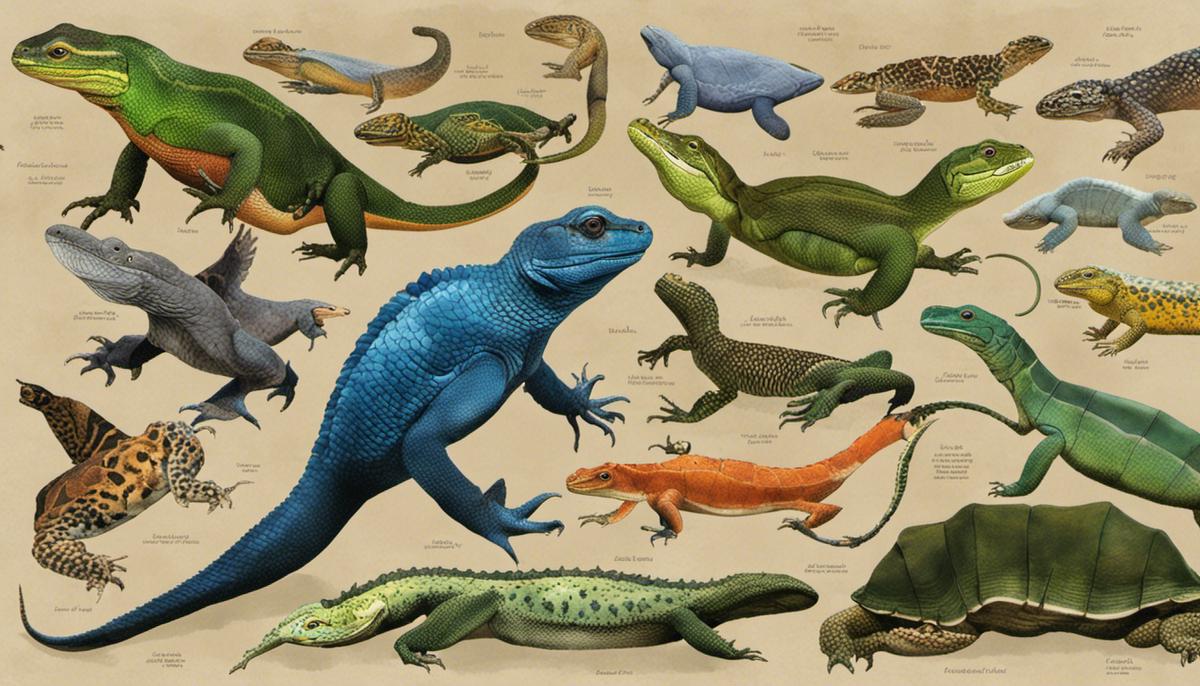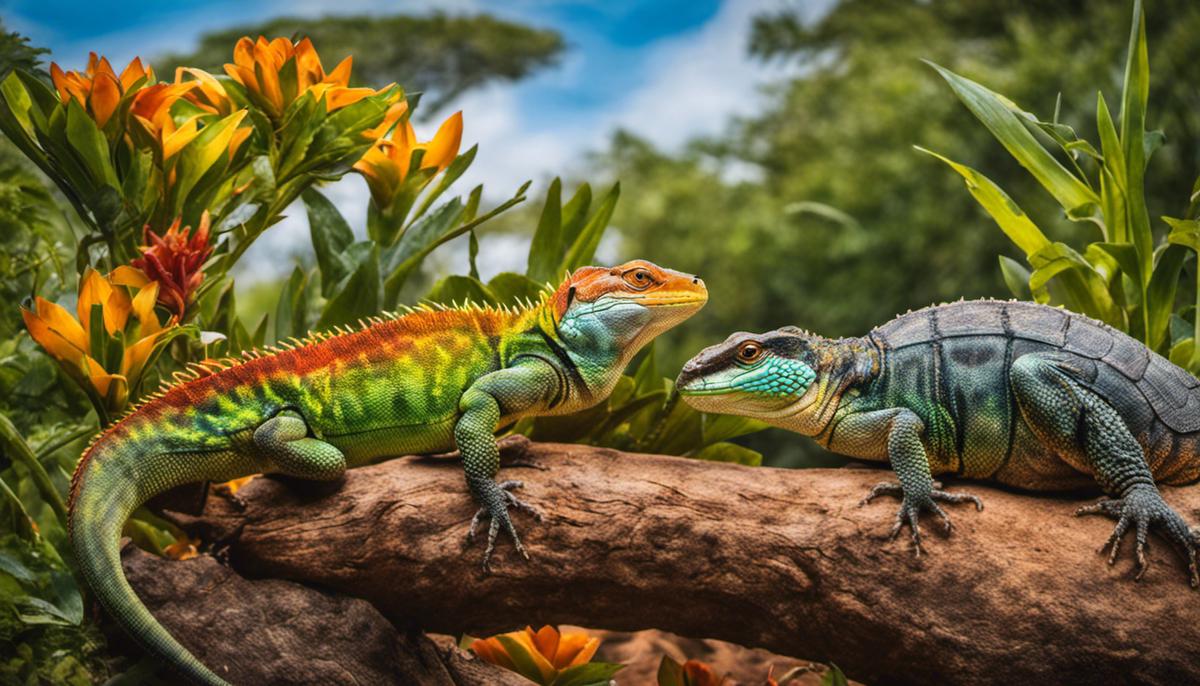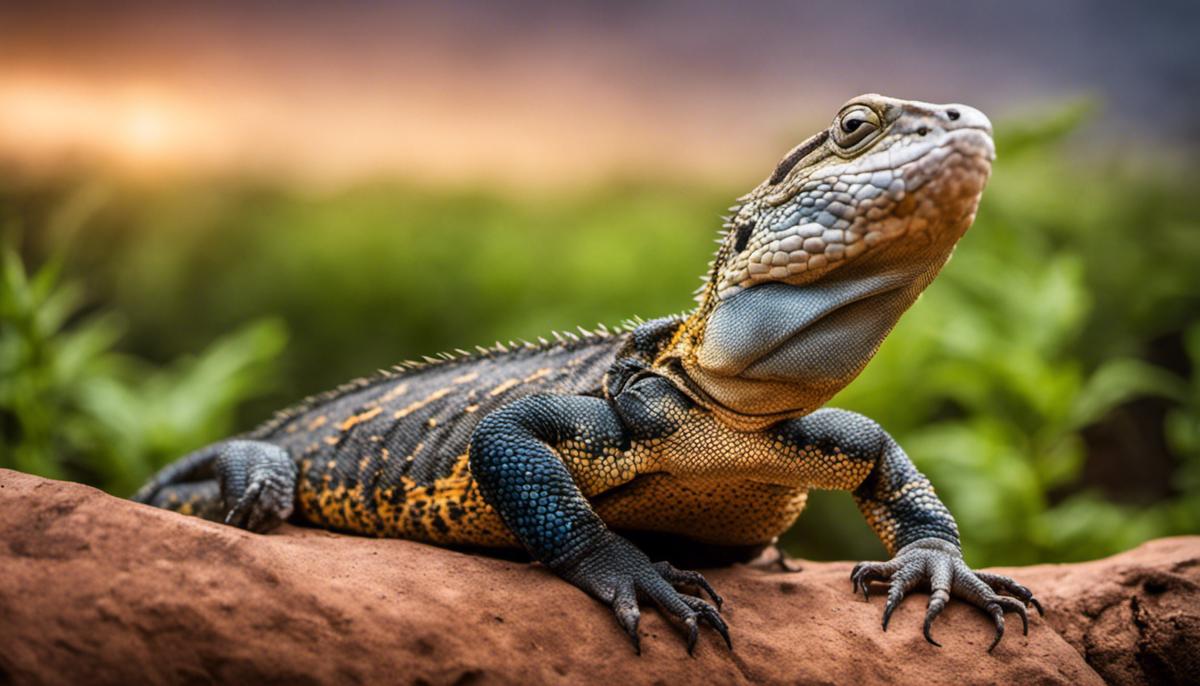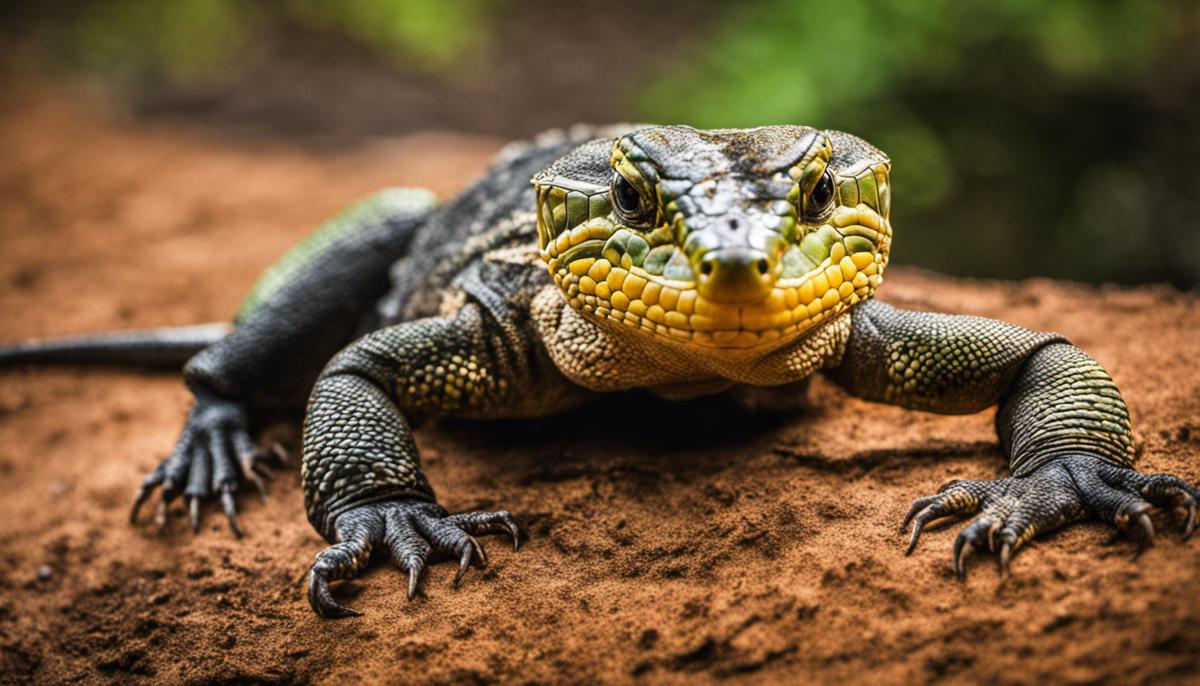Immersed in a rich tapestry of environmental diversity, Africa is home to a wide array of both fascinating and unique wildlife. A significant number of these are reptiles – creatures that flaunt the robust versatility nature has to offer. Unfortunately, many of them are also on the brink of extinction. Amid the tall grasslands and deep forests of Africa, there are ripples of life that are gradually dimming, pushed towards silence by a medley of threats. In this exploration, we delve into the endangered reptiles of Africa – distinctive in their form and behaviors, yet critically threatened – and comprehensively examine the threats facing them, the ongoing conservation efforts, and the crucial role of local communities in these endeavors.
Identifying Endangered Reptiles in Africa
Endangered Reptiles of Africa: A Closer Look at Standout Species
There’s something intrinsically captivating and mysterious about the world of reptiles. From their unique body structures to their incredible survival instincts, each reptile species serves as a testament to evolution’s finest work. That fascination intensifies when our focus shifts to Africa, home to some of the most diversified and endemic reptile species. Unfortunately, however, an increasing number is under the threat of extinction, their survival in peril due to varied factors including habitat degradation, illegal wildlife trade, and climate change. Let’s delve in and explore some of the standout endangered reptile species in Africa that require urgent conservation attention.
First on this list is the West African Slender-snouted Crocodile (Mecistops cataphractus). Recognizable due to its unique slender snout, this species occupies riverine habitats in the rainforests across West and Central Africa. This elusive crocodile’s population has been considerably reduced due to rampant skin trading and habitat destruction. IUCN Red List status? Critically Endangered.
Next up is the geometric tortoise (Psammobates geometricus), a species that can only be found in a mere handful of sites in the Southwestern Cape of South Africa. Blessed with a highly domed shell adorned with stunning yellow and black geometric patterns, the geometric tortoise is as visually striking as it is endangered. It is yet another victim of habitat destruction and fragmentation, primarily because of transformation of natural land for agricultural purposes.
The Nile crocodile (Crocodylus niloticus) is undoubtedly one of Africa’s most iconic reptiles. Though not yet endangered, certain populations are Vulnerable or Near Threatened. Threats to this species include habitat loss, persecution, and hunting for their skins and meat. Conservation steps are crucial to ensure that this fierce predator does not slide further down on the endangerment scale.
The Ploughshare Tortoise (Astrochelys yniphora) is truly worth noting. Endemic to Madagascar, it bears its name from the shape of its carapace which resembles a plowing tool. It is rated as Critically Endangered, owing to the illegal pet trade as well as agricultural activities that disrupt its natural habitat. For these slow-moving creatures, the race against extinction is a tough one.
Lastly, we turn our attention towards the iconic African Pancake Tortoise (Malacochersus tornieri). Recognizable from its flat, ‘pancake-like’ shell, this species employs a fascinating survival technique, taking refuge in crevices within rocky outcrops. Yet, despite such skill, they are listed as Critically Endangered due to extensive habitat loss and illegal pet trade.
Every single one of these species paints a captivating picture of the wondrous biodiversity in Africa and the magnificent complexity of our natural world. Their predicament, though dire, sprouts an invaluable lesson: preserving such diverse life forms lies within our grasp. It reminds us that it’s never too late to contribute whatever we can, whether through advocacy, direct involvement in conservation activities, or spreading awareness. Because, at the end of the day, the survival of these standout endangered reptiles depends on none other than us.
-

Beaded Dragon Fan Exclusive: ‘Original Hipster’ T-Shirt – Wear Your Unique Style with Pride – Unisex t-shirt
£13.00 – £20.50 Select options This product has multiple variants. The options may be chosen on the product page -

Chinese Water Dragon Aquatic Mastery Tee: Dive into Elegance with Our Exclusive Reptile Enthusiast Shirt – Unisex t-shirt
£13.00 – £20.50 Select options This product has multiple variants. The options may be chosen on the product page

Threats to Africa’s Endangered Reptiles
DEMANDING THREATS ENDANGERING AFRICAN REPTILES
If you’re an enthusiast of the scaled inhabitants of the wild, you’d know that African reptiles are some of the most unique species on planet Earth. Known for their incredible diversity, adaptability, and resilience, they represent a crucial element of the continent’s delicate ecosystem. Yet, these remarkable creatures are facing unprecedented challenges that are threatening their existence. This post seeks to shed light on these threats, focusing on species such as the Helmeted Terrapin (Pelomedusa subrufa), the Puff Adder (Bitis arietans), and the Giant Girdled Lizard (Cordylus giganteus).
Up first, the Helmeted Terrapin, a turtle species that thrives in numerous freshwater habitats across Africa. One of the greatest threats that this species is grappling with is habitat loss. Over-fishing and excessive harvesting of water resources have made survival an uphill task for these turtle species. Pollution, too, plays havoc on their existence – oil spills, eutrophication, and littering result in not just fatalities, but also genetic defects in offspring.
Bitis arietans, more commonly known as the Puff Adder, is a venomous viper species found in the African savannahs and grasslands. Today, climate change is their foremost enemy. Rapid alterations in temperature and rainfall patterns disrupt their breeding cycles and survival. Prolonged droughts or floods, amplified by climate change, decimate their habitats and food resources, pushing them towards the brink of extinction.
Last but not least, the Giant Girdled Lizard, a fascinating reptile primarily found in the rocky terrains of South Africa. Their major threat comes from the booming illicit pet trade. Because of their unique features and scarcity, they are heavily targeted by poachers, causing a severe decline in their population.
Apart from this, all three species face a growing threat from invasive species. Introduced either intentionally or accidentally, these unwelcome guests outcompete the native reptiles for food and habitat. They also introduce new diseases against which our African reptiles have no natural resistance.
All these threats are representative of the larger crisis that scores of other African reptiles are undergoing. It’s a call-to-action for all of us enthusiasts to raise awareness, promote responsible interaction with nature, and support regional conservation efforts. Let’s pledge to protect these amazing creatures and ensure that they continue to thrive in their natural habitats. Jump into the world of herpetology, and let’s make a difference!

Conservation Efforts for Africa’s Endangered Reptiles
Shifting our spotlight to another group of endangered reptiles in Africa, let’s delve further into the active measures being implemented to protect these remarkable yet vulnerable species. Focusing on Shield-nose Snakes (Aspidelaps lubricus), African Rock Pythons (Python sebae), Boulenger’s Tortoise (Chersina angulata), and Horned Adder (Bitis caudalis), we’ll uncover what efforts are being proactively undertaken for their survival.
The Shield-nose Snake’s conservation primarily involves maintaining and protecting its preferred habitats – sandy soils in arid shrublands and grasslands. Efforts include restricting construction and other forms of habitat destruction, preserving existing soil structures, and introducing legislation that protects this snake’s unique habitat.
For African Rock Pythons, massive advances in public education are making a significant difference. Because these large snakes often end up in conflict with local communities due to fear, misperceptions, and the illegal snake skin industry, educating the public about the snakes’ critical role in the ecosystem has been essential. These efforts aim to foster understanding and coexistence between humans and this misunderstood species.
When it comes to Boulenger’s Tortoise, this small, attractive species is often sought after in the illegal pet trade, making it critical that laws prohibiting their trade are enforced. Establishing captive breeding programs has gained much success. These initiatives make legally obtained tortoises available for pet owners, which helps decrease the demand for wild-caught individuals.
When discussing the Horned Adder, efforts are being made to understand the full scope of its distribution and to document the full range of threats it faces to develop targeted and effective conservation strategies. The current focus on this species centers around habitat protection, environmental education, and research to ensure the preservation of the species in the wild.
Invasive species pose a unique set of challenges across the continent. Efforts to manage invasive species include eradicating or controlling them, essential to give native species a better chance of recovery. Numerous projects and initiatives are underway in Africa to address these threats, from biological control methods to carefully managed population reduction techniques.
As for playing our part, raising awareness about these endangered reptiles and the threats they face is the first step. Support conservation organizations, both monetarily and by spreading their message. Educate others about the importance of protecting these species, not just for their survival but for the health of Africa’s ecosystems as a whole.
Lasty, responsible interaction with nature is essential. Always remember, treat all wildlife with respect, observe all visiting rules, and minimize your footprint when exploring their habitat. Never remove reptiles or other wildlife from their natural habitats. Each of us has a role to play in the survival of these extraordinary reptiles. Be knowledgeable, be passionate, be active. Together, we can make a change.

Involvement of Local Communities in Reptile Conservation
Diving into the world of reptile conservation in Africa, one cannot help but marvel at the myriad and frequently successful efforts of local communities.
Nestled within these communities lies an untapped resource of dedication and love for their home’s unique biodiversity.
The Shield-nose Snake, sturdy of build and utterly unique in appearance, is a prime example of the cooperation between conservationists and locals.
Throughout Africa, communities are actively participating in land management programs. These programs aim to sustainably balance agricultural needs with the preservation of the snake’s habitat, ensuring humans and snakes can cohabitate harmoniously.
Focusing their attention next on the captivating African Rock Python, education has risen as a key tool in protection efforts.
Local schools, community centers, and wildlife missions are encouraging knowledge sharing about the Python. These initiatives impart not only understanding of these impressive reptiles and their ecological importance but also foster a sense of ownership and responsibility among young and old to safeguard their population.
Taking a stand against the illegal pet trade, Boulenger’s Tortoise is witnessing a surge in protection.
This is largely attributed to initiatives where indigenous communities patrol local forests and wetlands, aiming to thwart traders at the source by reporting suspicious activities to enforcement authorities.
Delving into the desert world, the Horned Adder has emerged a beacon of successful conservation.
Strategies involving community engagement, like roping in local herdsmen and landowners, have strengthened the fight against habitat loss.
Their involvement ensures safer traveling routes for these reptiles, reducing chances of fatal encounters with humans or livestock.
The dire challenge of managing invasive species, a menace to Africa’s endemic wildlife, is also being tackled with encouraging outcomes.
For instance, community-led campaigns have been initiated to remove invasive plant species that threaten the natural habitats of various reptiles.
From grassroot level committees to the injection of manpower in manual clearance efforts, the integration and commitment of these communities are making a resounding impact.
Finally, local communities play a significant role in raising awareness and building support for conservation organizations.
From simple word-of-mouth advocacy to active participation in campaigns, local communities provide a backbone support that extends beyond immediate conservation areas.
This amplifies the reach of messages and actions aimed at ensuring the survival of these matchless species.
It becomes utterly clear that successful conservation finds roots in the engagement and commitment of local communities.
It’s an all-hands-on-deck approach, where every individual, from child to elder, contributes to the well-being of these significant reptiles.
Every action taken, whether it’s responsible interaction with wildlife, support for conservation organizations, or active involvement in conservation strategies, is an indispensable step towards securing the future of Africa’s extraordinary reptiles.
It illustrates a perfect blend of respect, responsibility, and love for these remarkable, cold-blooded companions who share our planet.

Endangered reptiles in Africa are part of an intricate interplay of life forms that make up the unique landscapes of the continent. Highlighting their plight is not merely about saving individual species, rather it’s a testament to preserving the delicate balance of our diverse ecosystem. Reversing the trend of extinction is a collective responsibility shared between governments, conservation organizations, and crucially, local communities. Through concerted efforts involving stringent policies, creative conservation initiatives, and community engagement, the hope for these exceptional creatures does not need to dwindle into oblivion. The struggle for saving Africa’s endangered reptiles is fundamentally a fight for a more balanced, diverse, and vibrant world.

